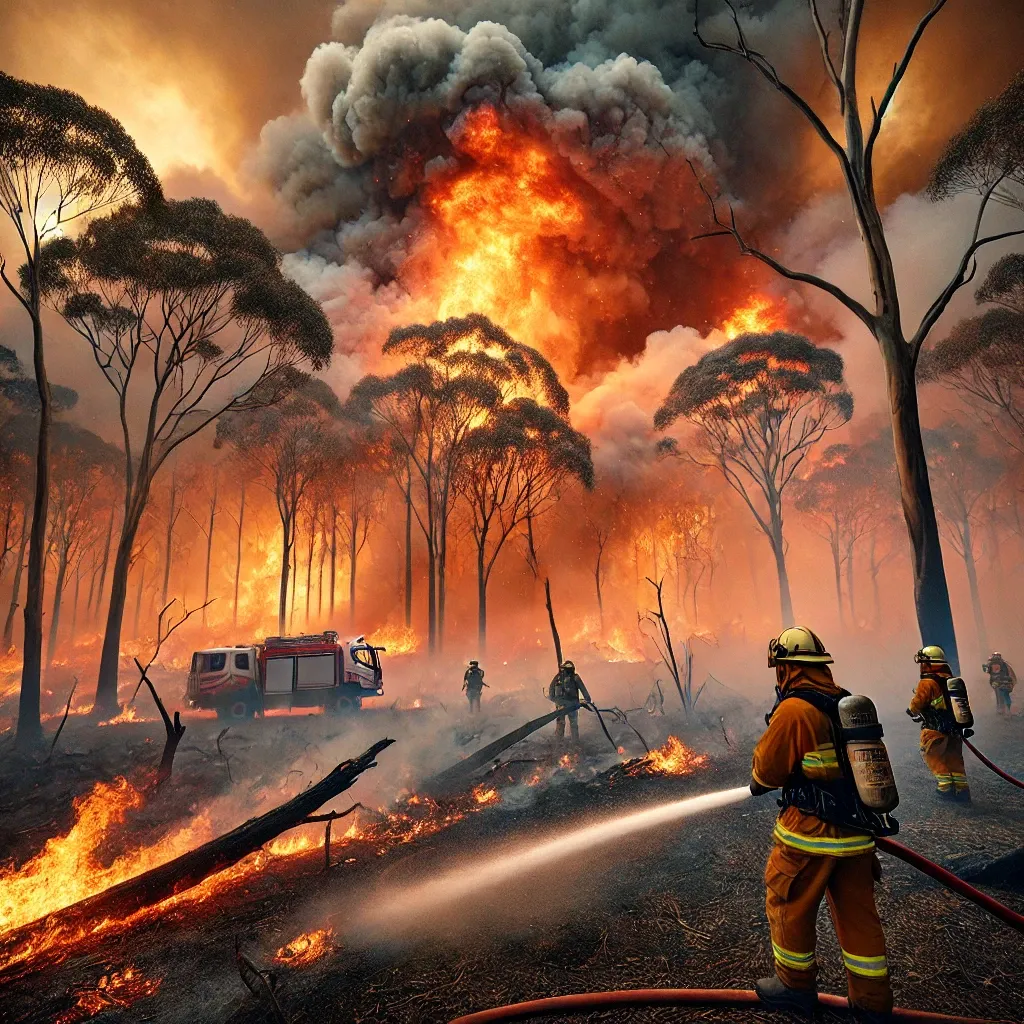Bushfires in Australia are a force of nature like no other. The crackling roar of a firestorm tearing through the bush, the oppressive heat radiating from the flames, and the suffocating smoke hanging in the air—it’s an experience that etches itself into the memory of any firefighter. For me, firefighting is not just a job; it’s a legacy. My father and grandfather stood on the frontlines before me, their courage and resilience paving the way for the lessons I live by today.
Now, I stand here in front of you, a group of bright-eyed teenagers, ready to take you on a journey into the heart of a bushfire. Not to scare you, but to show you the immense power of nature, the human spirit, and the critical importance of staying focused in life’s most challenging moments.
The Emotional Rollercoaster
Being in the midst of a large bushfire is an emotional whirlwind. Fear? Absolutely. Excitement? That too. But above all, there’s an unshakable determination to stay in control and protect what’s most important—lives, property, and the natural environment.
Imagine standing in the line of fire, quite literally. Flames stretch meters into the sky, the heat burns your skin even from a distance, and the smoke clouds your vision. Your heart pounds as you listen to the crackling of burning wood, the pop of exploding tree sap, and the eerie whistle of the wind driving the flames forward.
A Family Tradition
I often think about my father and grandfather in those moments. They faced fires with fewer resources, yet they had the same resolve. My grandfather used to say, “Fear keeps you sharp, but panic gets you killed.” It’s advice that applies not just to firefighting but to life. My father added to that wisdom: “Stay focused on the job at hand. The fire doesn’t care about your plans; it’ll change them in a second.”
This legacy is not just about fighting fires—it’s about carrying forward lessons that can guide you through life’s toughest battles.
Frequently Asked Questions
Facing challenges? Here are answers to commonly asked questions to guide you. If you need more help, we’re here for you.
01.
What services do you provide?
We offer firefighting, emergency response, and safety planning services to communities across the region. These services are aimed at ensuring public safety and preparedness.
02.
How do you handle fast-moving fires?
We rely on teamwork, adaptability, and real-time communication to assess fire behavior and execute safe responses. Continuous training also helps us stay prepared.
03.
What’s the key to staying calm in a fire?
Focus, preparation, and trust in your training are essential for remaining calm and effective during emergencies. Always follow safety protocols and guidelines.
04.
How do bushfires affect communities?
They can displace families, destroy homes, and cause environmental devastation. Quick response and community support are crucial to recovery.
05.
How important is teamwork?
Teamwork is everything. No one fights a fire alone. Each member plays a role to ensure safety and success, from strategizing to extinguishing fires.
06.
What’s the hardest part of firefighting?
Balancing physical exhaustion with the emotional toll of witnessing destruction and loss is one of the toughest challenges firefighters face.
07.
What should families do to prepare for emergencies?
Families should create a comprehensive evacuation plan, pack emergency kits with essential supplies, and stay informed about local risks and safety guidelines.
08.
How do you train new firefighters?
Training involves classroom instruction, hands-on drills, simulations, and mentoring to ensure recruits are prepared for real-world firefighting challenges.
09.
What role does technology play in firefighting?
Technology such as drones, thermal imaging, and real-time data tools helps improve situational awareness, resource allocation, and overall efficiency.
10.
What are the main causes of house fires?
Common causes include unattended cooking, faulty electrical wiring, improper use of heating equipment, and negligence with candles or smoking materials.
11.
How can businesses reduce fire risks?
Implement fire safety protocols, conduct regular fire drills, maintain fire extinguishers, and ensure compliance with local fire codes.
12.
What’s your most rewarding experience?
Witnessing lives saved and families reunited after emergencies is one of the most fulfilling aspects of being a firefighter.
13.
What should I do if I see a fire?
Stay calm, call emergency services immediately, and follow their instructions. Keep a safe distance and avoid taking unnecessary risks.
14.
How do wildfires affect wildlife?
Wildfires destroy habitats, displace animals, and disrupt ecosystems. Recovery often requires time and active conservation efforts.
15.
What’s the biggest lesson from firefighting?
Resilience, teamwork, and the importance of community support are the most significant lessons learned in the field of firefighting.
The Challenges of Battling a Bushfire
When you’re on the fireground, you’re not just facing flames—you’re battling the elements, time, and often your own instincts. A large bushfire is a living, breathing entity that shifts and changes with the wind, terrain, and fuel in its path.
The Unpredictable Beast
Bushfires are unpredictable. They can appear calm one moment, with flames smoldering low, and in an instant, a gust of wind can turn them into a raging inferno. As a firefighter, your job is to predict the unpredictable and stay ahead of the fire’s behavior.
This is no small task. You have to study the terrain—knowing where a fire might accelerate up a hill or slow down in a natural clearing. You watch the wind, because even the smallest change in direction can spell disaster. And you calculate how long your team has before conditions become too dangerous.
In those moments, fear isn’t your enemy; overconfidence is. I’ve seen firefighters underestimate a blaze, only to find themselves caught in its path. That’s why my team and I live by the mantra: “Plan for the worst, act with precision.”
Teamwork: The Backbone of Firefighting
No firefighter faces a blaze alone. It’s a team effort, and trust is the glue that holds it all together. Every member has a role, from operating the hoses to monitoring weather updates to scouting safe escape routes. Communication is critical, especially when every second counts.
I’ll never forget a fire I fought in the Blue Mountains. The blaze was fast-moving, and the winds were fierce. I was leading my team when we realized we were cut off. Our only way out was through a narrow firebreak, and we had to move quickly. The entire team relied on each other—no hesitation, no second-guessing. Everyone did their part, and we got out safely.
The Role of Strategy and Discipline
Strategy in firefighting is much like strategy in life. You have to think ahead, anticipate challenges, and adapt when things don’t go as planned. Discipline keeps you grounded. It ensures you stick to your training and don’t take unnecessary risks.
One lesson I always emphasize is the importance of situational awareness. Whether you’re fighting a bushfire or navigating a tough situation in your personal life, being aware of your surroundings and understanding the bigger picture can mean the difference between success and failure.
The Personal Toll and Life Lessons from the Fireground
Fighting a bushfire doesn’t just challenge your physical limits—it tests your mental and emotional resilience. The weight of the job doesn’t disappear when the flames are extinguished. For many firefighters, the memories of the fireground linger long after the last ember is out.
The Physical and Emotional Demands
The physical toll of battling a large bushfire is immense. You’re on your feet for hours, often in extreme heat, carrying heavy equipment and navigating treacherous terrain. Every breath draws in hot air and smoke, leaving your lungs burning. Hydration, stamina, and endurance become critical, and fatigue can quickly set in.
Yet, it’s the emotional weight that cuts deeper. Knowing that lives and homes depend on your actions is a heavy burden. I’ve stood in the ashes of a town after a fire, looking at families who’ve lost everything. You ask yourself: Did I do enough? Could we have saved more?
These moments remind you of the gravity of the job and the resilience needed to move forward.
Coping with the Aftermath
After a major bushfire, many firefighters wrestle with what they’ve seen. The devastation can feel overwhelming. For me, the camaraderie of my team has always been a lifeline. We lean on each other, sharing stories and offering support.
I’ve also found solace in passing on my experiences. Sharing these stories with younger generations helps me process the pain while giving others tools to face challenges in their own lives.
Lessons from the Flames
Bushfires teach you lessons that extend far beyond the fireground. Here are a few I hope you’ll carry with you:
1.Stay Calm Under Pressure: Panic clouds judgment. Whether you’re facing a raging fire or a tough situation in life, staying calm gives you the clarity to make smart decisions.
2.Adaptability is Key: No matter how well you plan, things can change in an instant. Being flexible and ready to pivot is essential.
3.Never Underestimate the Power of Nature: Fire, like life, is unpredictable. Respecting its power is crucial to surviving and thriving.
4.Rely on Your Team: Life isn’t meant to be faced alone. Surround yourself with people you trust and work together toward common goals.
5.Focus on the Bigger Picture: In the heat of the moment, it’s easy to get caught up in small details. Always remember why you’re doing what you’re doing and who you’re doing it for.
Building Resilience
Resilience isn’t something you’re born with; it’s something you build, brick by brick. Each fire I’ve faced has added to my ability to confront fear, adapt to challenges, and emerge stronger. It’s the same in life. Every setback is a chance to learn, grow, and prepare for the next challenge.
Conclusion – Lessons for Life from the Fireground
Standing in the glow of a bushfire is an experience that burns itself into your soul. It’s terrifying, exhilarating, and humbling all at once. As a firefighter, you confront forces far greater than yourself. But in doing so, you uncover strengths you never knew you had.
The Essence of Courage
Courage isn’t the absence of fear—it’s acting in spite of it. On the fireground, fear is a constant companion, but it doesn’t paralyze you. Instead, it sharpens your focus, reminding you of what’s at stake and urging you to act.
In life, the same principle applies. Whether you’re stepping into an exam room, facing a personal challenge, or chasing a dream, fear will always be there. The key is to channel that fear into action.
Focus and Presence
One of the greatest lessons firefighting has taught me is the importance of focus. When flames are licking at your boots and smoke fills the air, distractions can be deadly. You must remain present, fully aware of your surroundings and the task at hand.
This focus translates to everyday life. Too often, we’re pulled in a hundred directions, our attention scattered. But the moments that matter—those that shape our character and define our path—demand our full attention.
Respect for the Unpredictable
Life, like a bushfire, is unpredictable. It can shift direction without warning, throwing obstacles in your path. But it’s in these moments of uncertainty that growth happens. Facing the unknown with preparation, adaptability, and resilience is what sets you apart.
My grandfather used to tell me, “The fire doesn’t wait for you to be ready.” He was right. The same goes for opportunities and challenges in life—they come when they will, not when you want them to. The best you can do is prepare yourself to face them head-on.
The Power of Teamwork
Just as no firefighter battles a blaze alone, no one succeeds in life without support. The people you surround yourself with—your team, your family, your friends—are your safety net. Trust them, lean on them, and be there for them in return.
Carrying the Legacy Forward
As I look at you all, I see the next generation. You may not be firefighters, but you’ll face your own challenges, your own “fires.” Remember the lessons we’ve talked about today: courage, focus, adaptability, and teamwork. These are not just firefighting principles—they’re life principles.
One day, you’ll stand in the midst of your own storm. When that day comes, I hope you’ll think back to this conversation. Remember that fear can sharpen you, that focus can guide you, and that the people around you are your greatest strength.
A Final Thought
If there’s one thing I want you to take away, it’s this: life’s fires will test you, but they will also shape you. It’s not about avoiding the flames; it’s about walking through them with purpose and determination.
The bushfire will rage, the winds will shift, but with courage in your heart and a clear mind, you’ll emerge stronger on the other side.





